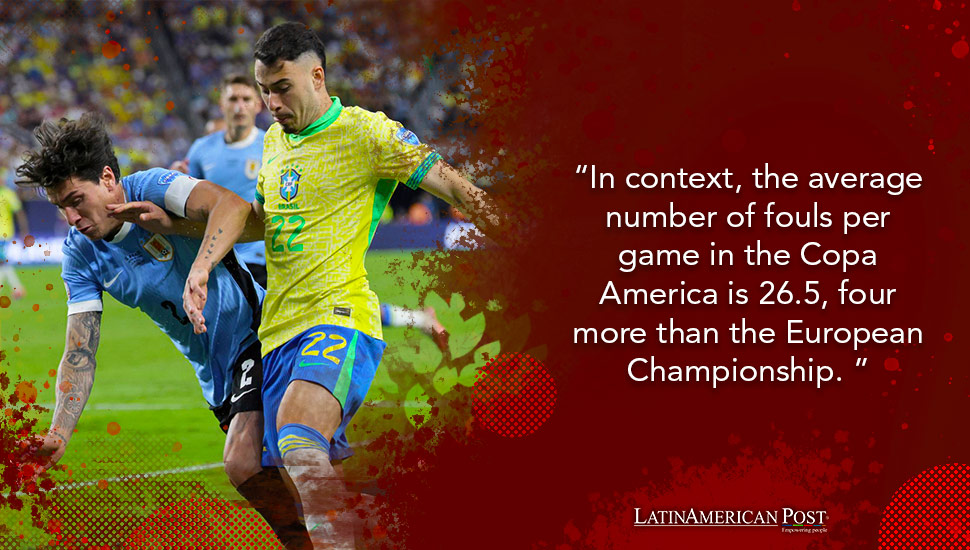Copa America 2024 Tactical Fouls Spark Controversy and Strategy Debate

The 2024 Copa America saw Uruguay and Brazil engage in a contentious match with a record number of fouls, sparking discussions on the role of tactical fouls in soccer and their cultural implications in South America.
I was taking one for the team. Or that should be 41 in the case of Uruguay against Brazil. That free kick count gave us the dirtiest game at Copa America 2024, knocking Chile versus Peru (37 fouls) off the top spot and providing a reference point for a conversation around a necessary evil in soccer: the tactical foul.
Purists look away now. Uruguay committed 25 fouls alone in that quarter-final in Las Vegas on Saturday night. In context, the average number of fouls per game in the Copa America is 26.5, four more than the European Championship. It’s just the South American way of doing things. But that’s an easy and lazy conclusion to draw. With both continental tournaments taking place simultaneously, comparisons are inevitable. But they’re also futile because it didn’t take long at the Copa America to realize that we’re watching a different game — and one that is refereed differently, too.
Cultural Nuances in Soccer Officiating
Soccer’s rules are the same worldwide, apart from the ones that are unwritten and shaped by culture as much as anything. Haranguing officials en masse is the norm at Copa America. Waving imaginary cards is tolerated, too, and players regularly get up close and personal with referees — even making physical contact. As for red cards, there’s a long conversation to be had before exiting the field (more than a minute in the case of Uruguay’s Nahitan Nandez). “Off you pop” — the three words the former Premier League referee Mike Dean said to Lewis Dunk after sending him off — wouldn’t cut it here.
The temptation to take the moral high ground came in 48 hours. This, after all, is a South American tournament. Who are we – a European, in this case – to sit in judgment? What is intriguing to analyze and explore, though, is the different ways in which South America’s ‘bigger’ teams have used fouls to help their cause tactically.
Reflecting on a data table at the end of the group stage that showed how the five CONCACAF teams had committed the fewest fouls per yellow card at Copa America, Fox Sports analyst Stu Holden made an interesting observation. “USMNT needs to foul more and play more physically. Can’t be so naive to this type of game in KO (knockout) tournaments,” Holden tweeted.
Uruguay’s Tactical Fouling
Uruguay is at the bottom of that table, averaging one yellow card per 36 fouls in the group stage, which fits the popular characterization of La Celeste as one of the most streetwise teams in the world. Or, to put it another way, Uruguay knows how to foul and get away with it.
That feels true, but it’s not as simple as that for several reasons. The first thing to say is that Marcelo Bielsa’s team presses high and aggressively, leading to a high proportion of fouls in the attacking third (5.8 per game, more than any other team at Copa America). They are the kind of fouls that rarely lead to a yellow card because of the area in the pitch where they occur, and, generally, the challenges aren’t aggressive. However, those fouls prevented the opposition from playing through Uruguay’s press and counterattacking.
Numerous examples of Darwin Nunez, Nicolas de la Cruz, Facundo Pellistri, and Maximiliano Araujo — generally Uruguay’s four most advanced players — commit that type of foul in the Copa America. Indeed, that attacking quartet is responsible for 26 fouls between them in four matches, which is more than the entire USMNT made across their three group games.
If we’re generous and give those attacking players the benefit of the doubt, they often run at maximum speed, and it’s hard to apply the brakes. An alternative view would be that anyone leading Uruguay’s press will not allow the opposition to play out or break the lines, come what may.
Impact of Refereeing Standards
Are they under explicit instructions to foul in that scenario? Nobody in the Uruguay camp would ever publicly admit that, but it wouldn’t be surprising. That goes for the tactics of plenty of other countries, too, mindful of what we see regularly at club level. In Amazon’s All or Nothing documentary series covering Manchester City’s 2017-18 season, Mikel Arteta, then assistant to Pep Guardiola, tells the team’s attacking players to make fouls if there is a transition. The logic is simple: the out-of-possession team can regain its shape without being exposed by a counterattack. There’s a lower probability of a yellow card being shown than when a defender commits a foul closer to their goal.
The graphic below shows where Uruguay’s fouls in the attacking third occurred. It also highlights Bielsa’s team’s success in regaining the ball in the same area through relentless running and pressing (5.8 recoveries per game, which, again, is more than any other team in the tournament). The smaller pitches at this Copa America tournament play into the hands of a team that presses as aggressively as Uruguay.
Watching every Uruguay foul at the Copa America confirmed something else: the tournament’s standard of refereeing has been inconsistent and desperately poor at best. For example, it was a minor miracle that Nandez managed to avoid a booking in the group stage before his red card against Brazil in the quarter-final. The Uruguay right-back made two fouls within 32 seconds against the U.S., and both could quickly have been deemed yellow card offenses.
De la Cruz could also count himself highly fortunate not to have a yellow card next to his name before Saturday’s wild quarter-final. Only Kevin Ortega, the Peruvian referee whose performance in the final group game against the U.S. was heavily criticized, knows why he booked Tyler Adams for a challenge on Mathias Olivera when the Uruguay left-back was the offender.
Tactical Fouling Across the Region
With all of that in mind, Uruguay has cracked the code when it comes to knowing how to stay just the right side of the line with yellow cards. In reality, they got off lightly before facing Brazil and they were not alone in that respect. It is clear that how Uruguay gets on top of teams in the final third, legally or illegally, is a fundamental part of their game under Bielsa. Cynical at times? Yes. Effective? Damn right. Their opponents are unable to get into any flow.
Some neutrals will rage, especially when Uruguay’s fouling can seem so systematic, which was the case against Brazil. But there are also plenty of people in South America and beyond who marvel at how a country of only 3.4 million can triumph against the odds. Brazil was not all sweetness and light, either. In their case, the midfield was the area where the majority of their fouls were made—often petty, arguably deliberate at times, and generally disruptive to the opposition.
The chief protagonists were Bruno Guimaraes, who has committed more fouls (13) than anyone else at Copa America, and Joao Gomes (10). As for Lucas Paqueta, he made more tackles than any other Brazil player, committed only four fouls but ended up with two yellow cards, which was twice as many as Guimaraes.
Gomes made half of his ten fouls against Uruguay, and it is no exaggeration to say that the Wolves midfielder could have been booked on three separate occasions before finally receiving a yellow card for a lunge on Nandez.
The Argentinian referee, Dario Herrera, was lenient throughout, letting things slide early in the game. He was like the supply teacher who walked into the lesson and was viewed as a soft touch within minutes. What followed was anarchy.
The Role of Tactical Fouls in Soccer Strategy
The free-kick patterns are less apparent with Argentina, but some exciting themes remain. The first of them is that Lautaro Martinez, the leading goalscorer at the Copa despite only starting two matches, averages a foul every 26 minutes, which is pretty much the same as Guimaraes. Martinez’s fouls are often from behind when he’s chasing back with little chance of getting the ball, forcing the opposition to restart and rebuild their attack.
Something else jumps out when you watch Argentina out of possession: the way their two center-backs, Cristian Romero and Lisandro Martinez, squeeze high up the pitch when the team is attacking and refuse to allow anyone to go past them if the ball is turned over. Both Romero and Martinez close down their opponent quickly and aggressively, get overly tight, and think nothing of making a tactical foul in the opposition half. You get the impression that’s all they’re thinking about at times.
They are also experts at turning on their heels and fleeing the scene as quickly as possible, barely giving the referee time to blow his whistle, let alone show a yellow card. Most significantly, that type of foul stops Argentina from being vulnerable to a counterattack and enables the team to regain its defensive structure, with every player behind the ball.
Below is an example of each one of those steps unfolding in the Ecuador quarter-final, when Romero clattered into the back of Enner Valencia and even had his arm around the striker’s head but somehow avoided being cautioned. Here, Lisandro Martinez is doing something similar against Chile after Lionel Messi lost control of the ball near the edge of the penalty area.
How Martinez reacts to the transition is fascinating: He closes down Eduardo Vargas at breakneck speed, cynically cleans the Chile striker out after he gets turned, and sprints away without even waiting to see how the referee will respond to that challenge. Argentina is now back in their 4-4-2 out-of-possession structure.
Our final case study is Colombia, who have played beautifully at the Copa America, scoring 11 goals across four matches and producing fast, free-flowing soccer. But they also have a couple of persistent foulers in Jhon Arias, hugely impressive in the half-space on the left, and the rampaging Daniel Munoz on the right.
Munoz locks down that right flank, where he attacks and defends aggressively. The Crystal Palace defender has two goals and one assist and has committed 12 fouls — the joint second-most at the Copa America — but avoided a yellow card. Seven of those fouls were against Brazil, and three were on Vinicius Junior — a point that the winger made to the referee.
Persistent fouling tends to go unpunished here because the threshold for showing a yellow card is so high, which naturally plays into the hands of some players. Indeed, the graphic below, which includes a CONCACAF player in the form of Canada’s Stephen Eustaquio, makes for exciting reading.
Where on earth is Jefferson Lerma? Lerma, remarkably, has committed only one foul in the Copa America so far. Alas, some things never change: the Colombia midfielder still picked up two yellow cards and got suspended for the quarter-finals. It was quite a feat.
Also read: AI Predictions Take Over Copa America 2024 Insights and Excitement
The Athletic provided the report and interviews for this article, detailing the tactics and cultural differences that shape the soccer game in South America.





